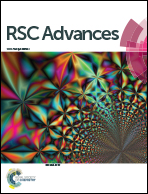Enhanced photoelectrochemical and photocatalytic activity by Cu2O/SrTiO3 p–n heterojunction via a facile deposition–precipitation technique
Abstract
In our study, a new visible-light-driven photocatalyst Cu2O/SrTiO3 (C/S) heterojunction was firstly prepared by a simple, facile and effective deposition–precipitation technique. The particle size of the Cu2O nanoparticle is only about 5 nm and the SrTiO3 (STO) nanocube is about 50 nm when modified by Cu2O nanoparticles. The samples are used as photocatalysts for photodegrading tetracycline (TC) under visible light irradiation. The 9-Cu2O/SrTiO3 (9-C/S) sample heterojunction shows the highest TC degradation ratio (77.65%), which is caused by the photogenerated electrons of the Cu2O nanoparticles moving from the conduction band of Cu2O to that of SrTiO3, resulting in the separation of electrons and holes. This study not only shows a possibility for substituting noble metals with low-cost Cu2O nanoparticles in photocatalytic degradation but also exhibits a facile deposition–precipitation technique for synthesizing narrow/wide band gap photocatalysts.


 Please wait while we load your content...
Please wait while we load your content...